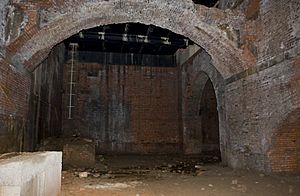Manchester and Salford Junction Canal facts for kids
The Manchester and Salford Junction Canal was a special waterway in the city of Manchester. It was built to connect two important canals: the Mersey and Irwell Navigation and the Rochdale Canal. This canal opened in 1839 but stopped being used in 1922.
Why the Canal Was Needed
Imagine trying to move goods across a city without a direct path! Before this canal, boats carrying goods on the Mersey and Irwell Navigation or the Rochdale Canal couldn't easily switch to the other. Workers had to unload the goods from boats onto carts. Then, they would carry them across Manchester's busy streets. Finally, they would load them onto new boats.
This process took a lot of time and cost a lot of money. It also made the streets of Manchester even more crowded. People realized a direct water link was needed to make transport easier and faster.
Building the Canal
As early as 1799, there were ideas to connect the canals. The Manchester Bolton & Bury Canal company even suggested building an aqueduct over the Mersey and Irwell Navigation. However, the Mersey and Irwell Navigation company didn't like this idea. They worried they would lose business. So, the plan didn't happen.
In 1805, an expert named John Nightingale looked into how much a canal link would cost. But nothing much happened for many years after that.
Things finally started moving in 1836 when John Gilbert became the engineer for the project. Building began soon after. While the Junction Canal was being built, another canal, the Hulme Locks Branch Canal, was also being finished. This new canal offered another way for boats to travel between the Rochdale Canal and the River Irwell. This meant some boats might not need the new Junction Canal after all.
The Manchester and Salford Junction Canal opened in 1839. Part of the money to build it came from the Manchester Bolton & Bury Canal company.
Later, in 1885, a huge building called the Great Northern Warehouse was built right over the canal. A special dock was created there. This allowed boats to unload goods directly into the warehouse. There were four large areas under the warehouse. They had two lifts to bring goods from the boats up into the warehouse for storage.
Why the Canal Closed
The Manchester and Salford Junction Canal was built at a time when railways were becoming very popular. Trains could carry goods much faster than canal boats. This made canals less important for transport.
Later, both the Bridgewater and Rochdale canals ended up being owned by the same company, the Manchester Ship Canal Company. This meant there was no longer a reason for them to compete using the Junction Canal. Because of this, the Junction Canal was officially closed in 1922.
During the Second World War, some parts of the canal were drained. They were then used as safe places for people to hide during air raids.
The Canal's Path
The canal was about 1 kilometer (5 furlongs) long. It ran from the River Irwell, near Quay Street, to a part of the Rochdale Canal, near Lower Mosley Street. Most of its path was through a long tunnel, about 499 meters (499 yards) long.
Today, the canal is dry and no longer used. However, large sections of it still exist underground beneath the city. You can find parts of it under the Great Northern Warehouse and Granada Studios. The original entrance on the western side can still be seen from the River Irwell. The eastern entrance has been changed into a small canal basin behind the Bridgewater Hall.
The canal used four locks to help boats move between different water levels. It also had two pumping stations to lift water from the River Irwell.


